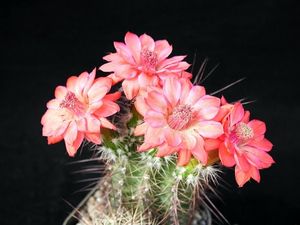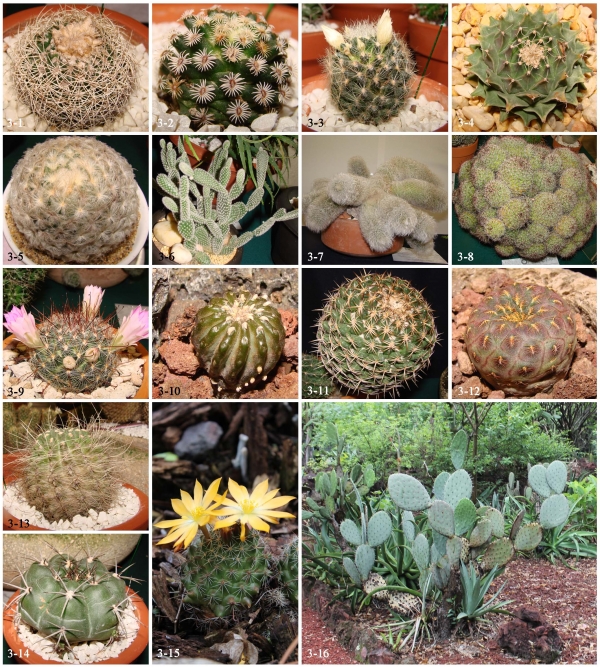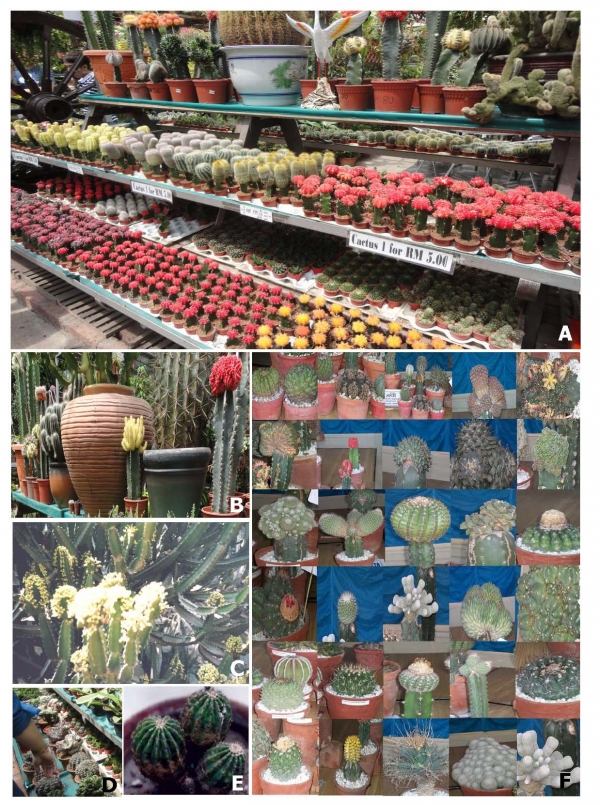Cactaceae: The cactus family
The Cactaceae is a family belonging to the order Caryophyllales. Cacti typically are found indry and ariddesert or semi-desert regions with high average daytimetemperatures and cold nights, and high evaporation rates. Cacti range from Canada to Argentina,predominantly occurring in the warm and arid reaches of the continents of both North and South America across a wide range of different habitats like deserts, sandy coastal stretches, scrublands, dry deciduous forests, high alpine steppes and tropical rain forests (Barthlott and Hunt, 1993; Gibson and Nobel, 1986; Nyffeler, 2001). The main diversity centers are Mexico and south-west USA, central Andes, Brazil, Paraguay, Uruguay and Argentina with Mexico being the richest and most endemic region (Boyle and Anderson, 2002; Ortega-Baes and Godínez-Alvarez, 2006). The family is classified into three subfamilies: Pereskioideae, Opuntioideae, and Cactoideae (Schumann, 1899; Barthlott and Hunt, 1993).
Contents
Physical Description
Cacti show remarkable variation in growth form includinglarge tree-likeor columnar forms,solitary orclumped globular or globose habits, andeven epiphytes and climbers. Cacti are characterized by highly organized fleshy stems and branches either bearing reduced or highly modified leaves or leaves are often replaced by specialized spines, hairs, bristles or scales borne to a central swollen fleshy structure called the areoles, which in turn is understood according to botanists to be a reduced form of a branch. Most cacti members are characterized by the presence of areole an important diagnostic character of the family. Among other important reproductive diagnostic characters of the family include presence of composite tubular floral structure, pericarpels and tepals. Cacti are champions of adaptations to difficult environment and are a great model of understanding plant evolutionary biology.
True leaves are quite rare among the family members to cope with their harsh desert environment. They generally have thin or think flattened or rounded stems for efficient absorption of available moisture in their dry and arid habitats with very little or low availability of water. Most terrestrial cacti have small or large spines as an effective protective measure against herbivores as well as for preventing the loss of moisture; while epiphytic members and climbers of the family usually have hairs or bristles providing similar function. This areolar arrangement of spines, bristles or scales show wide diversity among different members of the family showcasing spectacular morphological adaptations (Fig 1). The root system of several species have been found to be long, branched with intricate interwoven networks reaching great depths below the arid soil surface in search of available water of the water table. Cacti flowers are highly colorful and attractive bearing both accessory and reproductive whorls including intergrading sepals and petals forming composite tubular structure (with wide morphological modifications among different members), multiple stamens, single style and muti-lobed stigma. The flowers vary in color, shape and form across different genera and species (Figs 1-3) demonstrating a kaleidoscope of color and spectacular forms adorning their dry, desert gardens.

|
|
Physiological Adaptations
All cacti are succulents meaning that they have highly specialized water storage tissues. Another interesting physiological specialization of cacti is that most undergo the Crassulacean Acid Metabolism (CAM) pathway for photosynthesis that involves CO2 intake at night for conserving moisture due to comparatively lower rates of evaporation at night. The cacti capture the absorbed CO2 as an acid in this metabolic pathway which is eventually released during the day for the purpose of photosynthesis. Due to their low maintenance requirements and ability to withstand harsh environments, cacti have become extremely popular as ornamental and horticultural plants all across the planet. They are considered as “evolutionary milestones” in the history of plant evolution for colonizing the planet and demands respect from us in conserving and protecting several wild species in nature that have been seriously threatened by anthropogenic activities and global climate change.
List of members representing Cactaceae family is presented in table 1.
Table 1. Plants belonging to Cactaceae family.
|
|
|
|
|
|
|
|
|
|
|
|
|
| |
|
|
|
| |
|
|
| ||
|
|
| ||
|
|
|
| |
|
|
|
| |
|
|
|
| |
|
|
|
| |
|
|
|
| |
|
|
| ||
|
|
|
| |
|
|
|
| |
|
|
| ||
|
|
|
| |
|
|
| ||
|
|
|
| |
|
|
| ||
|
|
|
| |
|
|
| ||
|
|
|
| |
|
|
|
| |
|
|
| ||
|
|
| ||
|
|
|
| |
|
|
| ||
|
|
|
| |
|
|
| ||
|
|
|
| |
|
|
| ||
|
|
|
| |
|
|
| ||
|
|
| ||
|
|
|
| |
|
|
| ||
|
|
|
| |
|
|
| ||
|
|
|
| |
|
|
| ||
|
|
| ||
|
|
|
| |
|
|
| ||
|
|
|
|
|
|
|
|
|
|
|
| ||
|
|
|
| |
|
|
|
| |
|
|
| ||
|
|
| ||
|
|
|
| |
|
|
| ||
|
|
|
| |
|
|
| ||
|
|
|
| |
|
|
|
| |
|
|
| ||
|
|
|
| |
|
|
|
| |
|
|
|
| |
|
|
|
| |
|
|
| ||
|
|
|
| |
|
|
|
| |
|
|
|
| |
|
|
| ||
|
|
| ||
|
|
|
| |
|
|
| ||
|
|
| ||
|
|
| ||
|
|
|
| |
|
|
| ||
|
|
|
| |
|
|
| ||
|
|
|
| |
|
|
|
| |
|
|
|
| |
|
|
|
| |
|
|
| ||
|
|
| ||
|
|
|
| |
|
|
| ||
|
|
|
| |
|
|
| ||
|
|
|
| |
|
|
| ||
|
|
|
| |
|
|
| ||
|
|
| ||
|
|
| ||
|
|
| ||
|
|
|
|
References and Further Reading
- Anderson, Edward F. 1961 A taxonomic revision of Ariocarpus,Lophophora, Pelecyphora and Obregonia. PhD Dissertation,Claremont College.
- Anderson, Edward F. 1962. A revision of Ariocarpus (Cactaceae). II. The status of the proposed genus Neogomesia. The American Journal of Botany 49 (6): 615-622.
- Anderson, Edward F. 1966. The biography, ecology and taxonomy of Lophophora (Cactaceae). Brittonia 21: 299-310.
- Barthlott WD, Hunt DR 1993. Cactaceae. In: Kubitzki K, Rohwer JG, Bittrich V(eds.), Flowering plants: Dicotyledons, The Families and Genera of Vascular Plants Volume 2, 1993, pp 161-197, Springer Berlin Heidelberg, Berlin, Germany
- Boyle TH, Anderson E. 2002. Biodiversity and Conservation. In: Nobel, P.S. eds. (2002) Cacti. Biology and Uses. University of California Press, Los Angeles, pp. 125-141.
- Bruhn, J. C. 1975. Phenethylamines of Ariocarpus scapharostrus. Phytochemistry 15:2509-2510.
- Bruhn, J. C. and C. Bruhn. 1973. Alkaloids and ethnobotany of Mexican Peyote cacti and related species. Economic Botany 27(2):241-251.
- Casas A, Cruse-Sanders J, Morales E, Otero-Arnaiz A, Valiente-Banuet A. 2006, Maintenance of phenotypic and genotypic diversity in managed populations of Stenocereus stellatus (Cactaceae) by indigenous peoples in Central Mexico. Biodiversity Conservation 15:879-898.
- Castaneda, M. 1941. A new cactus. Cactus and Succulent Journal of America 13:98-99.
- OpenURLCavalcanti Filho JRC. 2010. A água como elo de identidades sociais no semi-árido paraibano: estudo de caso, Cabaceiras. Centro Universitário de Araraquara: Dissertação de mestrado (Mestrado em Desenvolvimento Regional e Meio Ambiente);196p. OpenURL
- Coulter, John Merle. 1894.Preliminary revision of the North American species of Cactus, Anhalonium, and Lophophora. Contributions from the U. S. National Herbarium 3(2):91-132.
- Dominguez, X. A., P. Rojas, M. Gutiérrez, N. Armenta and G de Lara. 1969. Estudio quimico preliminar de 31 cactáceas. Revista de Ia Sociedad Quimica de Mexico 13(1):8A-12A.
- Dominguez, X. A., R. H. Ramirez, 0. L. Ugaz, J. Garcia D., and R. Ketcham. 1968. Chemical study of the cactus Ariocarpus retusus. Planta Medica 16(2):182-183.
- Fernández-Alonso JL, 2006. Nueva especie colombiana de Browningia (Cactaceae, Cactoideae, Browningieae) potencialmente promisoria para el país. Revista de la Academia de Ciências Exactas, Físicas y Naturales. 30(114):19-30.
- Fitz Maurice, W.A. and B. Fizt Maurice. 1999.Fieldnotes Cact Succ J (U S) 71 271-272..New Locations for Ariocarpus agavoides.
- Fitz Maurice, W A , and T E Davis 1987. Fieldnotes Cact Succ J (U S) 59 144-145.
- Fuentes VR. 2005. Etnobotánica de Cactaceae em Cuba. In Memorias del Taller Conservación de cactus Cubanos. Cuba: Jardim Botánico Nacional, Universidad de La Habana. pp.15-24.
- Furst, Peter T. 1971. Ariocarpus retusus, the 'False Peyote' of Huichol Tradition. Economic Botany 25(2):182-187.
- Furst, Peter T. 1972. To find our life: Peyote among the Huichol Indians of Mexico. In: P. Furst, editor, Flesh of the Gods. Praeger Publishers, New York, pp. 136-184.
- Gibson AC, Nobel PS. 1986. The cactus primer. Harvard University Press, Cambridge, Massachusetts
- Glass, Charles and Robert Foster. 1974. Ariocarpus, Living Rock Cactus. Cactus and Succulent Journal of America 46(4):172-174.
- Gonzalez Q., L. 1972. Las Cactáceas Subfósiles de Tehuacán, Pue. Cactáceas y Suculentas Mexicanas 17(1):3-15.
- Jiménez-Sierra CL, Eguiarte LE, 2010. Candy barrel cactus (Echinocactus platyacantus Link & Otto): a traditional plant resource in Mexico subject to uncontrolled extraction and browsing. Economic Botany. 64(2):99-108.
- Kiesling, R. 1982. The genus Pterocactus. The Cactus and Succulent Journal of Great Britain 44 3:51–56.
- Kiesling, R. 2002. Pterocactus. (Cactaceae), nuevo registro para la flora de Chile. Gayana Botánica 59 2:61–63.
- Kiesling, R., J. Márquez, and N. Taylor. 2008. Pterocactus gonjianii. Curtis's Botanical Magazine 26 1–2:43–53.
- Lima JL. 1996. Plantas forrageiras das caatingas: usos e potencialidades. Petrolina: EMBRAPA, Brazil.
- Loza-Cornejo, S. and T. Terrazas. 1997. Stem and root anatomy of two species of Wilcoxia Britton and Rose (Cactaceae) of northeast Mexico. Boletín de la Sociedad Botánica de México 59:13–23.
- Loza-Cornejo, S. and T. Terrazas. 2003. Epidermal and hypodermal characteristics in North American Cactoideae (Cactaceae). Journal of Plant Research 116:27–35.
- Lyshede, O. B. 1982. Structure of the outer epidermal wall in xerophytes. In The Plant Cuticle. pp 87–98. Cutler, D. F., K. L. Alvin, and C. E. Price. eds. Academic Press. London.
- Nyffeler R. 2001. Phylogenetic relationships in the cactus family (Cactaceae) based on evidence from trnK/ matK and trnL-trnF sequences. doi: 10.3732/ajb.89.2.312 Am. J. Bot. February 2002 vol. 89 no. 2 312-326
- Ortega-Baes P, Godínez-Alvarez H. 2006. Global Diversity and Conservation Priorities in the Cactaceae. Biodiversity & Conservation, 15(3):817-827.
- Phillips O, Gentry AH, 1993. The useful plants of Tambopata, Peru: II. Additional hypothesis testing in quantitative ethnobotany. Econ Bot. 47:33-43.
- Phillips O, Gentry AH. 1993. The useful plants of tambopata, Peru: I. Statistical hypothesis tests with a new quantitative technique. Econ Bot 1993, 47:15-32.
- Pyke GH, 1984. Optimal foraging theory: a critical review. Annu Rev Ecol Evol Syst.15:523-575.
- Schumann K. 1899. Gesamtbeschreibung der Kakteen. Verlag J. Neumann, Neudamm, Germany.
- Sih A, Christensen B. 2001. Optimal diet theory: when does it work, and when and why does it fail? Anim Behav 2001, 61(2):379-390.
- USDA. 2014. Classification for Kingdom Plantae Down to Family Solanaceae. United States Department of Agriculture, Natural Resources Conservation Service. Available at: https://plants.usda.gov/java/ClassificationServlet?source=profile&symbol=Solanaceae&display=63 On 28th June, 2014
- Voldan, NI. 1976. Ariocarpus trigonus (Weber) K. Schumann var. minor Voldan, eine neue varietaet. Kakteen und andere Sukkulenten 27(11): 242-243.




